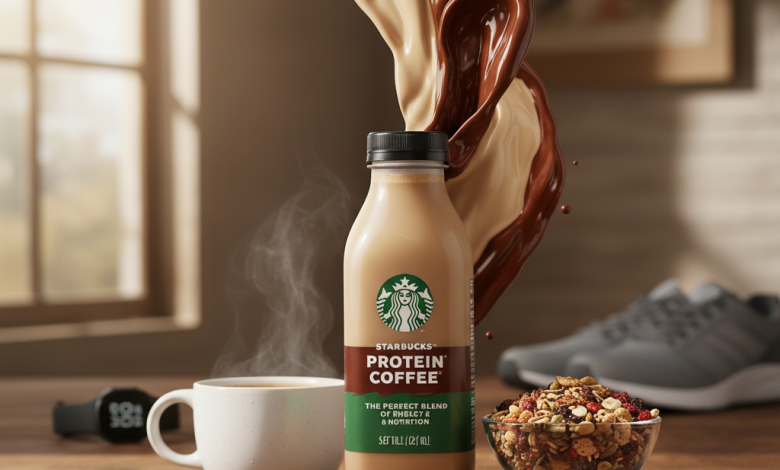Starbucks Protein Coffee: The Perfect Blend of Energy and Nutrition

In today’s fast-paced world, many people look for quick, convenient, and effective ways to fuel their bodies. Coffee has long been the go-to energy booster, while protein shakes have gained popularity among fitness enthusiasts and health-conscious individuals. Starbucks has found a way to combine both worlds into one innovative drink: Starbucks Protein Coffee. This beverage doesn’t just provide the caffeine kick we all crave—it also delivers a healthy dose of protein, making it a powerful blend of energy and nutrition.
We will take a deep dive into Starbucks Protein Coffee—what it is, its benefits, nutritional value, target audience, and how it compares to other options on the market. We’ll also explore why this drink is quickly becoming a favorite for busy professionals, fitness lovers, and anyone looking to maintain a healthier lifestyle.
What is Starbucks Protein Coffee?
Starbucks Protein Coffee is a beverage that combines Starbucks’ signature coffee with added protein, often through plant-based or dairy-based sources. It’s designed to serve as both a caffeine boost and a source of nutrition, providing sustained energy for people on the go.
Unlike a traditional latte or cappuccino, protein shake doesn’t just deliver flavor and caffeine—it also gives your body macronutrients essential for muscle repair, satiety, and sustained performance throughout the day. Starbucks has recognized the growing demand for functional beverages, and protein coffee fits perfectly into the brand’s strategy of offering healthier, more purposeful menu options.
Why Starbucks Entered the Protein Coffee Market
The rise of health-conscious consumers has reshaped the beverage industry. More people are looking for drinks that do more than satisfy taste—they want functional benefits. Coffee remains one of the most consumed beverages in the world, but today’s consumers also demand nutrition in their daily rituals.
Starbucks saw this opportunity and introduced Starbucks Protein Coffee to cater to:
- Fitness Enthusiasts: People who want a protein boost post-workout but still love their caffeine fix.
- Busy Professionals: Those who need quick, balanced fuel during hectic mornings.
- Health-Conscious Consumers: Individuals trying to cut back on sugar-laden beverages and replace them with nutrient-rich alternatives.
By merging protein and coffee, Starbucks is appealing to a wide range of customers while staying aligned with modern wellness trends.
Nutritional Value of Starbucks Protein Coffee
The exact nutritional content of Starbucks Protein Coffee may vary depending on the size and customization, but in general, it offers:
- Protein: 10–20 grams per serving (depending on size and recipe).
- Calories: Moderate, typically between 150–250 per drink.
- Caffeine: A similar amount to a standard latte or cold brew, depending on customization.
- Sugar Content: Lower compared to many sweetened Starbucks beverages, especially if customers opt for unsweetened or sugar-free flavors.
- Fat Content: Controlled, especially with plant-based milk options like almond or oat milk.
This makes the drink a well-rounded option for those seeking fuel without excess calories or sugars.
Benefits of Starbucks Protein Coffee
1. Dual Energy Source
Coffee provides a quick energy boost through caffeine, while protein ensures longer-lasting fuel for your muscles and metabolism. This dual benefit makes Starbucks Protein Coffee perfect for morning routines or midday slumps.
2. Supports Muscle Repair and Growth
Protein is crucial for muscle recovery, especially after workouts. Combining protein with coffee allows fitness lovers to enjoy their post-exercise fuel while still satisfying their coffee cravings.
3. Keeps You Fuller for Longer
Unlike regular coffee, which might leave you hungry within an hour, Starbucks Protein Coffee adds satiety thanks to its protein content. This makes it a good option for breakfast replacements or between-meal snacks.
4. Healthier Than Sugary Alternatives
Compared to frappuccinos or flavored lattes loaded with sugar, protein coffee can be a cleaner, more nutritious option. It’s particularly useful for those trying to reduce sugar intake.
5. Customizable Options
Starbucks allows customers to tailor their protein coffee—from milk type to sweeteners to flavorings. This customization ensures that customers can align the drink with their dietary needs.
Starbucks Protein Coffee Varieties
Starbucks has experimented with different protein coffee variations, which may include:
- Iced Protein Coffee – A refreshing, cold version ideal for summer or workouts.
- Hot Protein Latte – A warm, comforting protein-rich coffee.
- Plant-Based Protein Coffee – Made with oat, almond, or soy milk plus plant proteins for vegans and lactose-intolerant customers.
- Flavored Protein Coffee – Options like vanilla, mocha, or caramel with reduced sugar and added protein.
Each variety appeals to a slightly different audience, expanding Starbucks’ reach.
Who Should Try Starbucks Protein Coffee?
1. Athletes and Gym-Goers
Perfect as a pre- or post-workout beverage, Starbucks Protein Coffee provides both muscle fuel and energy.
2. Students and Professionals
Need to stay alert during long hours of study or work? This drink delivers focus without a sugar crash.
3. People on the Go
For those who don’t have time for a full breakfast, Starbucks Protein Coffee offers a convenient, nutritious alternative.
4. Health-Conscious Coffee Lovers
Anyone looking to cut down on sugar and add more protein to their diet will appreciate this option.
Comparing Starbucks Protein Coffee with Alternatives
While Starbucks is a leader in innovation, there are other protein coffee options available in the market. Some competitors include ready-to-drink brands like Premier Protein Café Latte or Muscle Milk Coffee Blend.
Here’s how Starbucks Protein Coffee stands out:
- Freshly Made: Unlike pre-packaged options, Starbucks’ drinks are freshly brewed and customizable.
- Accessibility: With thousands of locations worldwide, it’s easier to grab one compared to niche protein brands.
- Customization: Customers can choose size, flavor, milk, and protein type.
- Premium Experience: Starbucks maintains its premium coffeehouse atmosphere, elevating the drinking experience.
The Role of Starbucks Protein Coffee in Daily Nutrition
While Starbucks Protein Coffee is not a complete meal replacement, it can serve as a healthy addition to your daily routine. For instance:
- Morning Boost: Start your day with caffeine and protein for sustained energy.
- Midday Snack: Replace an unhealthy sugary snack with protein coffee to stay full and energized.
- Pre-Workout Drink: Get a caffeine kick plus amino acids for performance.
- Post-Workout Recovery: Aid muscle repair while recharging energy stores.
Adding fruits, nuts, or a light meal alongside protein coffee can make it even more balanced.
Potential Drawbacks of Starbucks Protein Coffee
While the drink offers numerous benefits, there are a few considerations:
- Calorie Content – Some versions may be higher in calories than expected, especially with flavor syrups or whole milk.
- Cost – Starbucks beverages are pricier compared to homemade protein shakes or regular coffee.
- Caffeine Sensitivity – Combining caffeine and protein may not be suitable for people sensitive to stimulants.
- Limited Availability – Not all Starbucks locations may offer protein coffee options yet.
Being mindful of customizations (like skipping extra sugar or choosing lighter milk options) can make this drink healthier.
Why Starbucks Protein Coffee is Becoming Popular
The popularity of Starbucks Protein Coffee comes down to modern lifestyle needs. People want quick, convenient, and functional foods that support both productivity and health. Instead of choosing between a coffee and a protein shake, they can have both in one. For those who drink coffee regularly, this option makes it easier to enjoy their daily caffeine while also getting an added protein boost.
This drink symbolizes Starbucks’ commitment to innovation and customer-centric offerings. With increasing demand for high-protein, low-sugar diet, protein coffee is likely to become a staple in the company’s global menu.
Tips for Customizing Your Starbucks Protein Coffee
If you want to make your drink even healthier, consider these tips:
- Opt for plant-based milk (almond, oat, soy) for lower fat and calorie options.
- Ask for sugar-free syrups if you want flavor without extra sugar.
- Balance protein levels by checking how many grams are added—adjust depending on whether it’s a snack or meal replacement.
- Choose iced versions for a refreshing, lighter drink.
- Pair with a protein snack for a more filling mini-meal.
Starbucks Protein Coffee and the Future of Functional Beverages
The beverage industry is evolving rapidly, with functional drinks leading the way. Consumers no longer want empty calories; they want drinks that help them perform better, recover faster, and live healthier. Starbucks Protein Coffee is part of this revolution.
Looking ahead, Starbucks may expand this line to include:
- Higher protein versions (25–30g protein).
- Keto-friendly protein coffees.
- Collagen-infused coffee for beauty-conscious consumers.
- Ready-to-drink bottled protein coffees available in supermarkets.
Such expansions would make Starbucks Protein Coffee even more accessible and appealing worldwide.
Conclusion
Starbucks Protein Coffee is more than just a trendy beverage—it’s a symbol of how modern consumers are redefining their relationship with food and drinks. By merging the energizing power of coffee with the nourishing benefits of protein, Starbucks has created a product that fits seamlessly into busy, health-conscious lifestyles.
Whether you’re a gym enthusiast needing recovery fuel, a professional powering through long workdays, or simply someone who wants a healthier alternative to sugary coffee drinks, Starbucks Protein Coffee offers the perfect blend of energy and nutrition.
With its growing popularity, customizability, and alignment with global health trends, it’s safe to say that Starbucks Protein Coffee is not just a passing fad—it’s here to stay.




